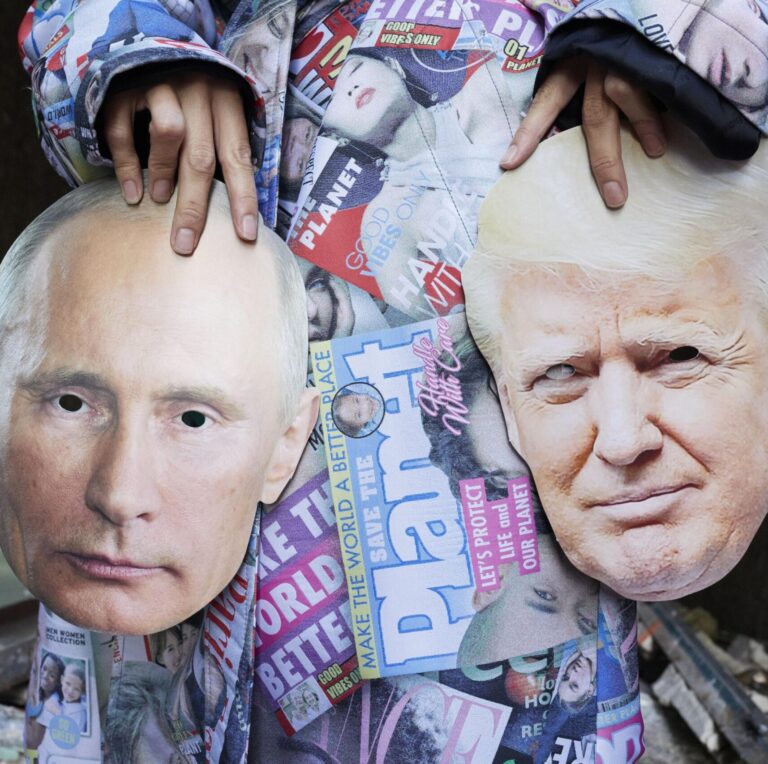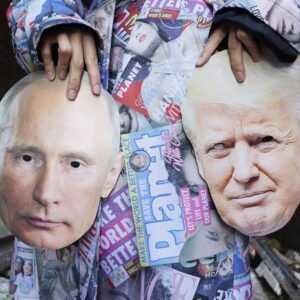
On the first day of installing his Roof Garden Commission at the Metropolitan Museum of Art, a falcon alighted on one of Petrit Halilaj’s wiry sculptures. This is the most specific the artist can get about the components of Abetare—a project that positions him amongst Lauren Halsey, Huma Bhabha, Pierre Huyghe, and other creatives who’ve left their mark on the institution’s canopy—before it opens to the public on April 30. But the bird’s gesture of welcome speaks to a central quality in Halilaj’s most significant U.S. presentation yet: It is an invitation.
The prolific Kosovar artist has excavated facets of his biography—growing up in the small village of Runik, fleeing with his family during the Kosovo War, meeting and making drawings for Kofi Annan while living in a refugee camp in Albania, coming out as gay—and the fraught destiny of his homeland throughout his career. With Abetare, Halilaj draws outside the lines of this narrative, looking to his neighbors, both in Eastern Europe and Central Park, to begin a new conversation. Ahead of the commission’s opening, he sat down to talk about weather conditions, questioning the center, and adding new letters to the alphabet.
CULTURED: This is your first solo presentation in New York since “RU” at the New Museum in 2017. How does it feel to be back?
Petrit Halilaj: I really missed it. But it’s also very, very new to me. The scale and the commitment of the Met Roof Garden Commission is kind of like coming out. You’re on the rooftop, and you say to all of New York, “Hey, I’m here!”
CULTURED: The exposure feels different because you’re literally outside.
Halilaj: Right after the invitation, I received the rules and the design context for the commission. They talked about the weather conditions—that whatever you do, basically, should be able to survive hurricanes. Metaphorically, that’s like “Baby, prepare.” And the Met is the only building that extends into Central Park, so I was super touched by how it’s connected to nature. When you work in an outdoor context, it just expands everything. You have to consider a complete set of new rules. I feel like they enrich your awareness.

CULTURED: For Manifesta 14 in Pristina, Kosovo, you made an installation that sits above the grand hotel, titled When the Sun Goes Away, We Paint the Sky. You donated it to the people of Pristina, so it will stay intact until the building is sold. It’s become a part of the city’s skyscape. How have you considered the New York skyline with this commission?
Halilaj: For me, it’s about questioning how the city will be completed by the work and the work will be completed by the city, the animals, and everything around. I looked into the history of the commissions, and I saw that most of the works had been placed in the center. I wanted to bring a polyphony of sculptures that [ask you] to discover them. I placed sculptures on the periphery and left the middle for the public. I wanted the skyline of New York and the people to be the main actors that would activate the work. I come from a country that just recently got a voice, culturally speaking. I don’t know what being central means. I don’t know what the center means. We have to exercise all of this. And since people are important to me, I cannot leave them aside. I want to leave that space to people, so they will realize that actually they are in the middle.
CULTURED: It destabilizes the hierarchy of how we think of public artwork—the monument being something central and phallic, like an obelisk.
Halilaj: My internal challenge was how to not go down that path. If I think about the Manifesta 14 work, one of the things I loved the most is that you could only read the sentence if you walked around the four sides of the hotel. The work required your time and the completion of a cycle to be grasped fully.
CULTURED: Tell me about the ecosystem that shaped the piece. What did you research?
Halilaj: I had [an additional] year because they extended it from the past commission. This gave me the right amount of time—it’s been almost four years from the invitation to now. In terms of research, many of my projects are related to Kosovo, but I was very excited to have time to expand my knowledge and connection beyond my homeland and the region. It’s an orchestra of different voices, a symphony of fragments. I went to very small Eastern European towns that made history or shaped me personally. I thought, What if instead of just knowing about, for example, Macedonia through the news of my artist friends, I went and explored it in a personal way?
Between my studies at the Brera Academy in Milan, my move to Berlin [Halilaj lives and works between Berlin, Pristina, and Bozzolo, Italy], and starting to travel with my work, I saw distance as a way to save my life from being sucked up by politics. My journey to get to know and accept myself is strictly related to the destiny of Kosovo—a country that also deserves official recognition. This was reflected in my [2020] show at Madrid’s Palacio de Cristal, where my partner Álvaro Urbano and I planned to have our marriage celebration.
Spain doesn’t recognize [Kosovo as a country], but it does recognize LGBTQI rights more than Kosovo. In Kosovo, Álvaro is accepted as a Spanish citizen, but not as my husband. During that show, the Spanish government [and Museo Reina Sofía] received phone calls and emails from the Foreign Ministry of Serbia, which doesn’t recognize Kosovo’s statehood, asking them to remove my nationality from the wall text in the museum and from the website. The director was like, “I have never been asked to rewrite the wall text.” That might sound like something of the past, but it’s still my experience. So in a way, going back to Albania, Macedonia, and Montenegro, as well as other countries in Eastern Europe, and doing this research on very small schools and different alphabets, I was looking for a new idea of home—in conversation with the region.

CULTURED: You’ve named the commission Abetare, which is a language and alphabet textbook written in Albanian. You’ve made many works and shows with this title over the years. What does it mean in this context?
Halilaj: My intention was almost to add an “s” and say, “What are Abetares in the places around Kosovo? What are we taught through school education, and how does it structure our knowledge? How do we find spaces of freedom within this system?” It’s the idea of relearning the way I see neighbors and having to learn other sides of the story to overcome resentment and fear. We have so many similar regional issues and struggles. It made me feel like we’re all in the same classroom. I wanted to see the beauty of that, but also to go beyond my own language, because that’s what I learned all these years through art.
CULTURED: It feels like the goal of the installation is to think of a new alphabet, or to expand the alphabet. Maybe there are more letters that we don’t even know of yet!
Halilaj: Exactly. It’s an invitation for us to add our own letters. It goes toward abstraction, which I love, and this idea of doodling. You don’t carve time and space for yourself only when you know what you want; sometimes you carve that freedom when you don’t know where to go. I’m not trying to bring a finished story, I’m trying to trigger people to start their own. We might feel very small in the face of history, even with the wars going on now, but through this installation, I hope to hint that each of us has a place to rewrite, redraw, or add something to the world. It’s a beginning.










 in your life?
in your life?

